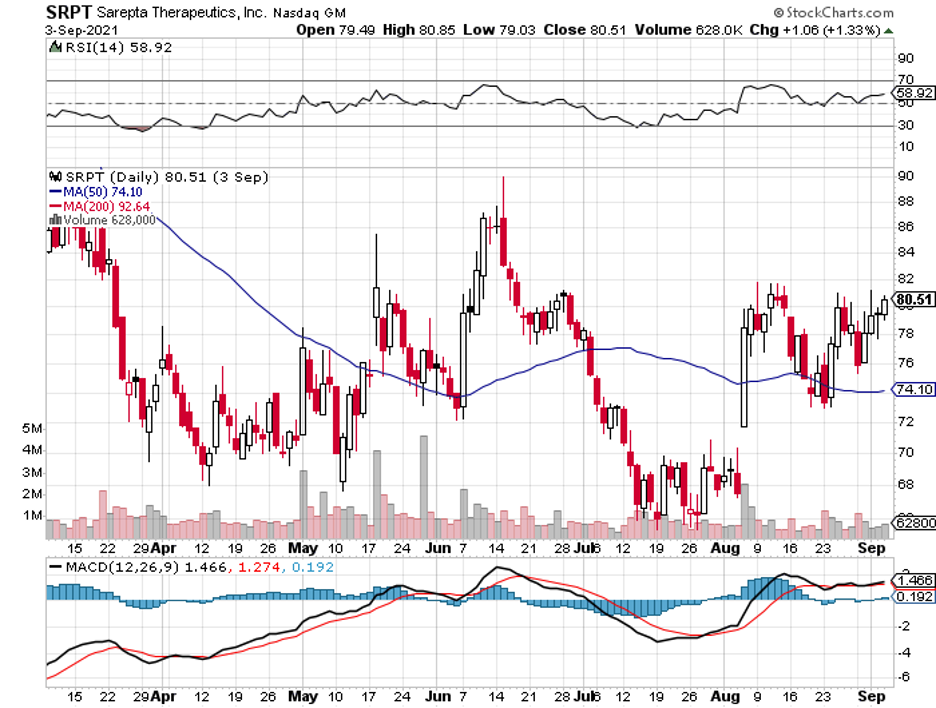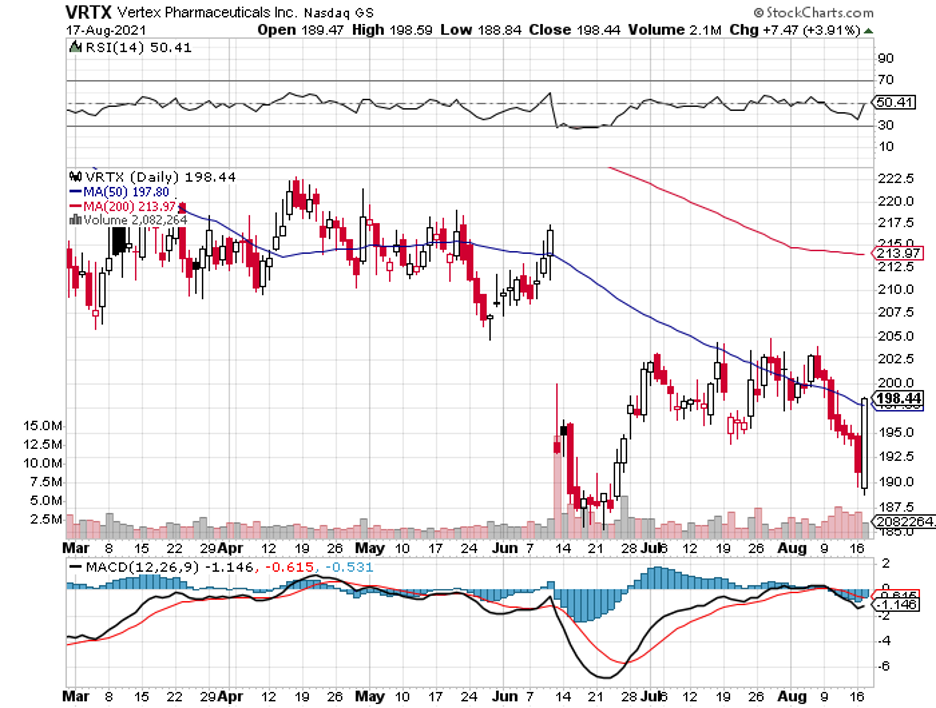Mad Hedge Biotech & Healthcare Letter
September 9, 2021
Fiat Lux
FEATURED TRADE:
(A STOCK FOR BARGAIN HUNTERS)
(SRPT), (MRNA), (BNTX), (FGEN), (ACAD), (RARE), (BLUE), (CRSP), (PFE)

Mad Hedge Biotech & Healthcare Letter
September 9, 2021
Fiat Lux
FEATURED TRADE:
(A STOCK FOR BARGAIN HUNTERS)
(SRPT), (MRNA), (BNTX), (FGEN), (ACAD), (RARE), (BLUE), (CRSP), (PFE)

Biotechnology stocks that have fallen by over half since 2021 started are strewn around in the market.
While the share prices of COVID-19 stocks, such as Moderna (MRNA) and BioNTech (BNTX), have skyrocketed, the others in the sector are not as fortunate.
The biotechnology segment has been filled with relative horror stories from previous favorites like FibroGen (FGEN), Acadia Pharmaceuticals (ACAD), and Ultragenyx Pharmaceutical (RARE).
Among the companies hit with disappointing news, the gene therapy sector, which has stocks like bluebird bio (BLUE) and CRISPR Therapeutics (CRSP), appears to be having a tougher time than most.
So, where does this situation leave investors? Where should we look for value?
One tactic that would help value investors take advantage of this abysmal situation is studying Wall Street analysts' moves.
Look at target prices they set for the stocks they cover and then choose the companies trading the farthest below the expected price points.
Among the biotechnology stocks struggling these days, one of the names that emerged as a truly promising investment is Sarepta Therapeutics (SRPT).
To say that Sarepta has been experiencing a disappointing year is an understatement. Shares of this company have gone on a 57% heart-stopping plunge since 2021 started.
In fact, this biotech’s nosedive is the third-worst in the midcap or larger stock sector based on the two key exchange-traded funds: iShares Biotechnology ETF (IBB) and SPDR S&P Biotech ETF (XBI).
Despite Sarepta’s abysmal performance, Wall Street still labels the stock a buy.
Sarepta’s decline started in early January when the trial results for its gene therapy for Duchenne muscular dystrophy (DMD) failed to impress investors.
However, the subsequent trial for the same gene therapy, dubbed as SRP-9001, is anticipated to yield better results.
Although the results are expected to be released by late 2022 or early 2023, holding the stock for now is estimated to deliver remarkable profits for patient investors.
At this point, Sarepta stock is trading at roughly $80 per share.
However, experts predict that the next results for SRP-9001 would push the shares to climb to over $200.
DMD, which is a rare degenerative condition characterized by gradual weakening of the muscles, affects about 16,840 people in the US.
So far, the US FDA has only approved a handful of treatments for DMD—three of which are RNA-based drugs developed by Sarepta.
Evidently, the company has a firm grasp of the condition and a proven track record of launching and marketing DMD-centered products.
More importantly, this makes Sarepta a dominant—if not the most dominant—force in the DMD market.
What makes their newest treatment, SRP-9001, different is that it works on DNA. Despite the extended timeline, Sarepta’s candidate remains the frontrunner in this endeavor.
Its closest threat is PF-06939926, an investigational drug from Pfizer (PFE) that uses the same technology as SRP-9001.
At the very least, this competitor is two years away from producing any tangible result.
By the time Pfizer reaches Phase 3, Sarepta’s SRP-9001 has already generated roughly $1 billion in sales.
Apart from the three approved drugs, Sarepta still has 34 drug development programs focused on two niches: RNA and AVV gene therapies. Among them, 7 are already in the clinical stage, including SRP-9001.
If successful, the company will reach $1 billion in revenues by 2023.
Another reason that makes Sarepta an attractive opportunity is its notably intact cash flow backbone—an achievement that’s worth pointing out considering its underwhelming SRP-9001 results.
The company also has an impressive history.
Sarepta has blossomed from its humble beginnings working as a contractor for the Department of Defense on the Ebola virus. Since then, it has developed its pipeline through acquisitions and launching effective treatments for rare diseases.
While Sarepta’s treatments are effective, they cannot cure DMD. They can only slow its progression.
This means continuous and life-long use among patients. For context, one treatment costs an average of $300,000 per patient annually.
Although it lost over 50% of its value, Sarepta still has enough capacity to rebound soon.
The factors that would help the company achieve this include the strong lineup of products generating solid and predictable revenues as well as its promising pipeline.
More importantly, its struggles with SRP-9001 don’t seem enough for the company to scrap the project altogether.
If anything, it proved that Sarepta can explore more potent treatments for DMD by looking into RNA technology—a path that the likes of Moderna and BioNTech have already found success in.
Overall, I think Sarepta still has a lot left in the tank. It operates in one of the most exciting sectors.
It’s worth bearing in mind that the biotech sector is ripe with innovation from companies with the ability to conjure up life-changing treatments—a value perceived as a crucial hallmark for massive gains.
Needless to say, Sarepta’s achievements in the DMD sector and its growth trajectory make it a shoo-in in this category.

Mad Hedge Biotech & Healthcare Letter
August 19, 2021
Fiat Lux
FEATURED TRADE:
A LOW-PROFILE BIOTECH WINNER
(VRTX), (ACAD), (SRPT), (FGEN), (MRK), (MRNA), (NVS), (XLRN), (PTGX), (IONS), (BLUE), (EDIT), (ABBV)

Choosing winners among biotechnology and healthcare stocks these days isn’t easy.
Since the year started, the sector has been marred with several unexpected disappointments like the 50% decline of crowd favorites Acadia Pharmaceuticals (ACAD) and Sarepta Therapeutics as well as the 33% fall of the ever-dependable FibroGen (FGEN).
So, how can investors pick a winner?
One tactic is taking a peek at what Wall Street analysts are doing, noting which among the companies they’re following are trading the farthest below the estimated price points.
Among the names on the list, a particular stock stands out as a strong contender these days: Vertex Pharmaceuticals (VRTX).
Although it’s one of the most widely known biotechnology companies today, Vertex actually started in a garage of a Harvard-trained chemist, Joshua Bogner, who left his cushy job at one of the most illustrious big pharma companies at that time, Merck (MRK), to pursue his vision.
The company’s raison d’être was a major selling point for a lot of talented and idealistic scientists in that era.
That is, Vertex wanted to find cures for the most challenging diseases and do this in an unbureaucratic setting.
Since then, Vertex’s goal has been straightforward: tackle the most complex and toughest diseases and deliver breakthrough treatments that offer tangible benefits to patients.
Over the years, the company has managed to keep this goal at the forefront of its efforts, starting with its work on the devastating genetic disorder called cystic fibrosis (CF).
Vertex’s work on CF took over a decade, but it eventually led to an impressive franchise that helped with the treatment of patients.
In the first quarter of 2021 alone, sales in this segment reached $1.7 billion.
Expanding on its work, Vertex has explored genetic therapies and set up a collaboration with Moderna (MRNA) in 2016.
Using the latter’s well-established expertise in messenger RNA technology, the companies are expected to come up with more aggressive and advanced CF treatments in the coming years.
Given these developments, Vertex reiterated its 2021 sales guidance to be somewhere in the range of $6.7 and $6.9 billion. Meanwhile, sales of its CF franchise are estimated to peak at $9 to $10 billion—if not higher—by 2024.
Aside from its work on CF, Vertex has also been pouring resources on developing treatments for severe sickle cell anemia and beta thalassemia, a rare blood disorder.
In fact, the company has been looking into these developments as the next major revenue stream, as seen in its bolstered collaboration deal with CRISPR Therapeutics (CRSP).
In this deal, Vertex paid the smaller biotechnology company $900 million upfront plus a potential addition of $200 million following the first regulatory approval of their therapy, CTX001.
While this may sound like a hefty deal to some, Vertex actually values CTX001 at roughly $11 billion.
CTX001, which is a one-time therapy, is priced at roughly $1 million per patient. At this point, the market for beta thalassemia is valued at $32 billion.
Needless to say, this would make CTX001 a massive income generator in the next few years.
Considering the lucrative market for beta thalassemia, though, it’s no surprise that several competitors have emerged to grab their share as well.
Some companies, such as Novartis (NVS) and Acceleron (XLRN), offer maintenance drugs for the disease.
Meanwhile, others like Protagonist Therapeutics (PTGX) and Ionis Pharmaceuticals (IONS) are attempting to develop treatments that would become direct competitors of CTX001.
However, the closest rivals of the Vertex-CRISPR candidate are from Bluebird Bio (BLUE) and Editas Medicine (EDIT).
While this has become a crowded space, Vertex and CRISPR remain the leaders in this segment, as most of the other candidates are still in the investigation phase.
Since it was founded in the 1980s, Vertex has remained true to its vision of tackling some of the toughest diseases out there.
While big pharmaceutical companies, such as AbbVie (ABBV), decided to expand their portfolio through acquisitions, Vertex leveraged its talent pool and maximized its funds by establishing strategic collaborations instead.
This tactic provided the company with enough elbow room that eventually led to its dominance in the CF space, where it now enjoys a virtual monopoly until at least the next decade.
Meanwhile, it has forged strong relationships with promising biotechnology companies and can very well be on its way to becoming the most dominant force in the rare blood disorder segment.
Overall, Vertex Pharmaceuticals is an attractive stock with an impressive portfolio and an even more impressive pipeline.

Legal Disclaimer
There is a very high degree of risk involved in trading. Past results are not indicative of future returns. MadHedgeFundTrader.com and all individuals affiliated with this site assume no responsibilities for your trading and investment results. The indicators, strategies, columns, articles and all other features are for educational purposes only and should not be construed as investment advice. Information for futures trading observations are obtained from sources believed to be reliable, but we do not warrant its completeness or accuracy, or warrant any results from the use of the information. Your use of the trading observations is entirely at your own risk and it is your sole responsibility to evaluate the accuracy, completeness and usefulness of the information. You must assess the risk of any trade with your broker and make your own independent decisions regarding any securities mentioned herein. Affiliates of MadHedgeFundTrader.com may have a position or effect transactions in the securities described herein (or options thereon) and/or otherwise employ trading strategies that may be consistent or inconsistent with the provided strategies.
This site uses cookies. By continuing to browse the site, you are agreeing to our use of cookies.
OKLearn moreWe may request cookies to be set on your device. We use cookies to let us know when you visit our websites, how you interact with us, to enrich your user experience, and to customize your relationship with our website.
Click on the different category headings to find out more. You can also change some of your preferences. Note that blocking some types of cookies may impact your experience on our websites and the services we are able to offer.
These cookies are strictly necessary to provide you with services available through our website and to use some of its features.
Because these cookies are strictly necessary to deliver the website, refuseing them will have impact how our site functions. You always can block or delete cookies by changing your browser settings and force blocking all cookies on this website. But this will always prompt you to accept/refuse cookies when revisiting our site.
We fully respect if you want to refuse cookies but to avoid asking you again and again kindly allow us to store a cookie for that. You are free to opt out any time or opt in for other cookies to get a better experience. If you refuse cookies we will remove all set cookies in our domain.
We provide you with a list of stored cookies on your computer in our domain so you can check what we stored. Due to security reasons we are not able to show or modify cookies from other domains. You can check these in your browser security settings.
These cookies collect information that is used either in aggregate form to help us understand how our website is being used or how effective our marketing campaigns are, or to help us customize our website and application for you in order to enhance your experience.
If you do not want that we track your visist to our site you can disable tracking in your browser here:
We also use different external services like Google Webfonts, Google Maps, and external Video providers. Since these providers may collect personal data like your IP address we allow you to block them here. Please be aware that this might heavily reduce the functionality and appearance of our site. Changes will take effect once you reload the page.
Google Webfont Settings:
Google Map Settings:
Vimeo and Youtube video embeds:
